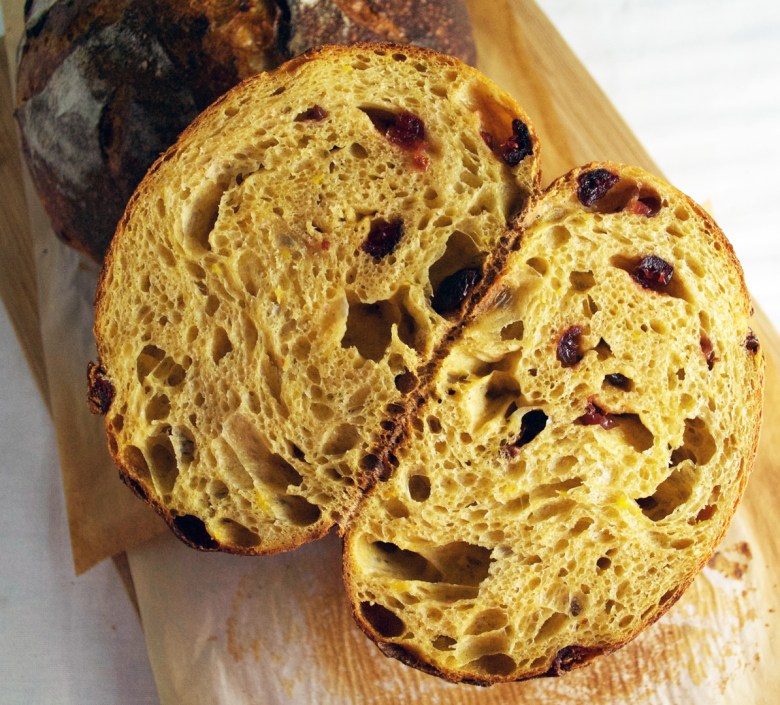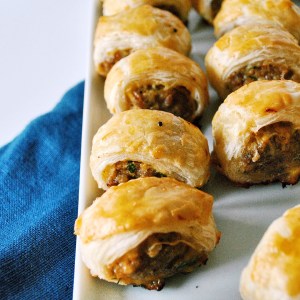
When it comes to pies, I’ve definitely been more on team sweet than team savory. But after watching Great British Bake Off and seeing those hand-raised hot water crusts, picnic pies, and pasties, I was itching to make some kind of savory pie. We ended up having a family Thanksmas dinner a bit early this year because a few of us are traveling over the holidays, so a fridge full of turkey leftovers presented the perfect opportunity for some pie-experimenting.
Pie fillings are quite adaptable; I think as long as you have the right consistency and amount, you can play around with the ingredients and flavorings. I really wanted to make a pot pie filling that didn’t contain milk or cream sort-of-not-really for health reasons (I’m lactose intolerant; I can handle butter and small amounts of dairy, but cream sauces generally don’t go over well). Originally I was going to use some leftover mashed potatoes for thickener, but someone ate them…so pureed squash it was! My family enjoyed this gravy, but if you prefer something more traditional you can sub some of the stock for whole milk or cream. Also, I know peas usually show up in these sort of pies but I am NOT a peas fan so none here! If you don’t have such aversions, feel free to stir some in with the sage at the very end.
I used this sourdough crust adapted from Maurizio (subbing buttermilk for the vinegar and omitting the sugar; I also added a few healthy grinds of black pepper and the leaves of one thyme sprig), and it was perfect for this — sturdy yet flaky and packed with flavor! If you’ve got starter on hand I definitely recommend this route, but if you don’t your favorite pie crust recipe will do nicely. I added a couple of turns to the pastry which gives it extra flake and makes it easier to roll out, IMO — also totally optional. The filling is the perfect amount for my deep-ish pie dish; if you use a normal pie plate you’ll probably have some leftover for a baby pie or to eat over rice.
A few notes:
- See this post for some general pie baking tips.
- I think the trick to avoiding a soggy bottom crust is starting with chilled pastry AND filling. If you add the filling when it’s still warm, you’ll melt the butter in the bottom crust and likely end up with goop. I also baked the pie on a preheated stone in the lower third of the oven the entire time. If you don’t have a stone, preheat a sheet pan in your oven and bake your pie on that.
- A few weeks ago I made a small batch of apple jelly and have been using it as a secret flavor ingredient in stews and marinades — I love it! That being said, I know it’s not a common ingredient to have around; so you could probably substitute 1/4 c of apple juice or cider for stock for a similar effect.
Turkey and Sage Pot Pie
Makes one deepish 9-inch pie
Ingredients
- 1 recipe of your favorite double pie crust
- 3 cups cooked turkey, shredded or diced
- 2 medium carrots, diced
- 2 celery stalks, diced
- 1 c mushrooms, sliced
- 1 large onion, diced
- 2-3 cloves garlic, minced
- 1/4 c flour
- 1/4 c butter
- 1 1/2 c turkey or chicken stock (I used low-sodium)
- 1/2 c squash puree
- 1 bay leaf
- 1 T apple jelly (optional, see notes above)
- 1/2 c leftover gravy
- 2 T finely minced fresh sage leaves
- Salt and pepper, to taste
- Olive oil
- 1 egg beaten with 1 tsp water or milk, for egg wash
Method
- In a medium saucepan over medium heat, saute the onion and garlic in olive oil until slightly softened, 2-3 minutes. Add the carrots and celery, season with salt and pepper, and saute until carrots are slightly softened but not mushy, about 5-7 minutes. Remove vegetables from saucepan and set aside.
- In the same saucepan over medium heat, melt the butter. Add the flour all at once, stirring constantly, and cook for 1-2 minutes until a golden paste forms. Slowly pour in the stock, stirring constantly to avoid clumping. When the gravy is slightly thickened, stir in the leftover gravy, squash, and optional jelly, followed by the bay leaf and mushrooms. Turn down to medium low and simmer for 3-4 minutes, or until the mushrooms are mostly cooked. Add the reserved vegetables and turkey. Cook for 3-4 minutes until the turkey is heated through, then remove from the heat and stir in the sage. Allow to cool for about 10 minutes, then cover and refrigerate until cooled completely (about an hour).
- Preheat your oven to 400F with a rack (and baking stone, if you have one) in the bottom third of the oven.
- While the filling is cooling, prepare the pie crusts. Roll out your bottom crust and transfer it to a greased pie plate. Trim crust so you have an overhang of about 1 inch. Cover with plastic and refrigerate while you roll out your top crust. Cut into strips for a lattice, if desired, or keep whole. Transfer to a sheet pan and refrigerate until ready to assemble.
- When your filling is chilled and oven is ready, spoon the filling evenly into the bottom crust (remove the bay leaf). Top as desired (with a lattice or not), and crimp the edges to seal. Refrigerate for about 10-15 minutes, or until the pastry is firm.
- When ready to bake your pie, gently brush the egg wash over the top, being careful not to drag the filling onto the crust. Cut a few steam vents in the top if baking a non-lattice pie. Bake for 20 minutes, then turn the oven down to 375F and bake for another 30-45 minutes, rotating halfway through for even baking. The filling should be bubbling and the pastry golden brown. (Note: if your pastry is browning too quickly, tent with foil.) Allow to cool slightly before serving.








 I’ve made sausage rolls in the past using store bought puff pastry and that works perfectly well. But lately I’ve been into making my own rough puff. I use
I’ve made sausage rolls in the past using store bought puff pastry and that works perfectly well. But lately I’ve been into making my own rough puff. I use 